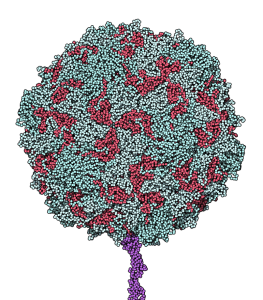By Antoine Dufour, PDF in Overall Lab
Proteases are enzymes that play fundamental roles in diverse aspects of biology by mediating the cleavage of specific substrates. During a viral infection viruses utilize proteases both to process their own proteins and to modify the host proteome. Although initially viewed as ”collateral damage” resulting from viral replication these cleavages in host proteins have increasingly been recognized as specific, targeted events which aim to impede antiviral responses and collectively facilitate viral infection. Despite their importance, viral mediated cleavages are extremely challenging to identify and characterize.
All picornaviruses encode a conserved protease, the 3C protease that is essential for viral synthesis and replication. Within the Picornavirus viral family few host proteins are known to be targets of viral proteases but the full repertoire remains to be elucidated. Previous targets have been identified using different techniques, such as candidate gene/protein approaches and bioinformatics, but these methods have limitations for the discovery of novel substrates, as they are often biased towards previously known targets.
As published in the Journal of Virology, Dr. Jan lab at the UBC Department of Biochemistry in collaboration with Dr. Overall group at CBR used an unbiased proteomics-based approach – terminal amine isotopic labeling of substrates (TAILS) -to conduct a global analysis of protease-generated N-terminal peptides by mass spectrometry of a human cell line treated with the poliovirus 3C protease. This approach identified several novel substrates that are cleaved by the protease. Of particular interest was a heterogeneous nuclear ribonucleoprotein M (hnRNP M) -a RNA-binding protein that shuttles between nucleus and cytoplasm in normal human cells, primarily known for its role in pre-mRNA splicing. This study demonstrated that hnRNP M underwent a drastic relocalization from the nucleus to the cytoplasm in poliovirus infected cells and was proteolytically cleaved. Interestingly, the depletion of hnRNP M decreased poliovirus infection suggesting that hnRNP M plays a facilitative role within the poliovirus life cycle. Similar results were observed during coxsackie virus infection, suggesting that cleavage of hnRNP M is a common strategy for picornaviruses to facilitate infection.
Identification of novel viral protease substrates will not only expand our understanding of viral-host interactions required for successful infections, but also contribute to our knowledge on the regulatory networks of fundamental cellular processes. Furthermore, global unbiased approaches such as TAILS used for studying viral proteases, showed to be a good method for discovering novel substrates and consequently new potential anti-viral therapies.




